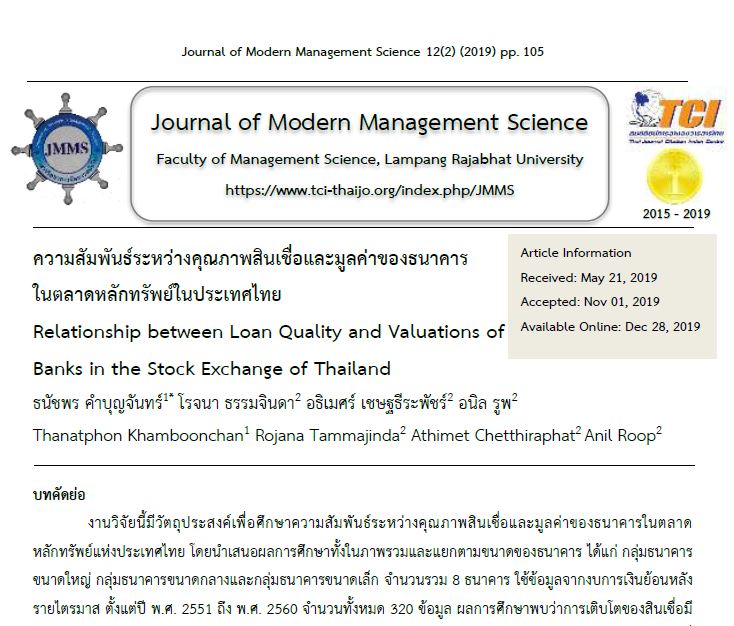Relationship Between Loan Quality and Valuations of Banks in The Stock Exchange of Thailand
Main Article Content
Abstract
This independent study aim to test the relationship between loan quality and value of banks in The Stock Exchange of Thailand. The analysis are conducted both overview data and different groups separated by size – large, medium and small. Using secondary data form quarterly financial statements, from 2008 to 2017. Loan quality were measured by loan growth and non-performing loans. The value of banks measured by Tobin’s Q. Control variables include size of banks (SIZE), amount of capital (CAPITAL), amount of loans (LOANS), amount of deposits (DEPOSITS) and Asset diversity (AD).
The results showed that loan growth are significantly inversely correlated with value of banks in The Stock Exchange of Thailand while non-performing loans have no correlation with the value of banks in The Stock Exchange of Thailand. According to the sized group analysis, the results showed that loan growth are correlated inversely proportional to the value of large banks and medium bank but not with small banks. Another finding reveals that non-performing loans are significantly positive with the value of large banks, but non-performing loans are correlated inversely with the value of medium bank. No correlation is found with small banks. The interaction effect analysis was conducted to test the influence of loan growth to the relationship between non-performing loans and the value of banks in The Stock Exchange of Thailand. The results showed that the coefficient on interaction term is negative and significant. The more increasing of loan growth, the less value of banks when having more non-performing loans.
Article Details
The article must be considered and accepted for publication by the editorial board of the Faculty of Management Science, Lampang Rajabhat University. The articles have been reviewed by a peer (peer review) and the author must update according to the suggestion if available before publication. Articles that are not considered the editorial team will inform the results of the consideration but will not send the original to the author.
JMMS is the Faculty of Management Science journal, Lampang Rajabhat University. Jmms published both print and online editions. We allow the use of articles for academic use under the scope of copyright law.
References
ธนาคารแห่งประเทศไทย. (2561). ผลดำเนินงานของระบบธนาคารพาณิชย์ปี 2560. (ออนไลน์). 29 พฤศจิกายน 2561 สืบค้นจากhttps://www.bot.or.th/Thai/FinancialInstitutions/Publications/FIProformance_Press/
n5361t.pdf
ศูนย์วิจัยกสิกรไทย. (2550). 10 ปีวิกฤติเศรษฐกิจไทย 2540: บทเรียนของสถาบันการเงินไทย. (ออนไลน์).
29 พฤศจิกายน 2561 สืบค้นจาก www.rcim.rmutr.ac.th
วิกานดา ใจสมุทร. (2558). อิทธิพลของปริมาณหนี้ที่ไม่ก่อให้เกิดรายได้ (NPLs) ต่อความสามารถในการทำกำไรของธนาคารพาณิชย์ที่จดทะเบียนในตลาดหลักทรัพย์แห่งประเทศไทย. (รายงานผลการวิจัย). บัณฑิตวิทยาลัย มหาวิทยาลัยกรุงเทพ
Caprio, G., Laeven, L., & Levine, R. (2003). Governance and Bank Valuation. (Online). National Bureau of Economic Research. Retrieved November 29, 2018 from https://www.nber.org/papers/w10158.
Clair, T. (1992). Loan Growth and Loan Quality: Some Preliminary Evidence from Texas banks. Federal Reserve Bank of Dallas Economic Review, 9–22.
Fahlenbrach, R., Prilmeier, R., & Stulz, M. (2016). Why does Fast Loan Growth Predict Poor Performance for Banks? Technical Report National Bureau of Economic Research.
Fu, L., Singhal, R., & Parkas, M. (2016). Tobin’s q Ratio and Firm Performance. International Research Journal.
Igan, D., & Pinheiro, M. (2011). Credit Growth and Bank Soundness: Fast and Furious? IMF Working Paper, 11(278), 4-7.
Mwinlaaru, Y., Ofori, K., Adiyiah, A., & Idun, A. (2016). Non-Performing Loans and Universal Bank’s Profitability. MPRA Paper.
Niu, J. (2016). Loan Growth and Bank Valuations. The Quarterly Review of Economics and Finance, 61, 185–191.
Tobin, J. (1969). A General Equilibrium Approach to Monetary Theory. Journal of Money, Credit and Banking, 1, 15-29.
Willim, P. (2015). Price Book Value & Tobin's q: Which one is better for Measure Corporate Governance? European Journal of Business and Management, 78-79.
Zemel, M. (2012). The Information Content of Loan Growth in Banks. Stern School of Business, New York University Working Paper.

